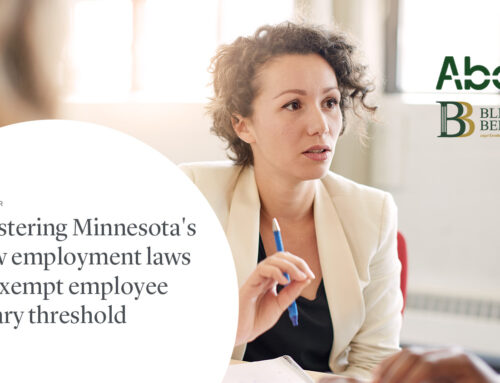The 2023 Minnesota Legislative session is off to a busy start, and a top priority for Democratic leaders and the Governor is paid family and medical leave for all Minnesota employees. A bill has been introduced to provide for this leave and it appears likely to pass in some form. This bill, in its current form, would likely have very significant impacts on all Minnesota employers and as a result, employers need to be aware of (1) the bill’s proposed terms, (2) how individuals and businesses can provide feedback, and (3) what’s to come if and when this bill passes.
Summary of the Bill
You can read the bill in its current form here. Please note that this bill may have amendments between now and the time it is voted on, so the information below is provided based on the bill in its current form.
Employer Eligibility. Every employer in the State of Minnesota would be mandated to participate regardless of size. Employers have the option to opt out of the program if they offer a leave program at least as generous as the state mandate. To do so, employers must submit their plans to the state for approval, and employers who opt out will be assessed a fee.
Employee Eligibility. An employee becomes eligible for the paid leave 90 days after they are hired.
Funding for the Program. The paid leave program will be funded with a 0.7% payroll tax. At this time, there is no cap on the payroll tax, meaning that if the costs for the program exceed the amount collected, the payroll tax would likely increase. Employers may “charge back” employees for up to 50% of the tax, but must do so under proportion, contract, or wage requirements.
Length of Leave and Benefit Amount. There are two major types of leave available:
- Paid Medical Leave – up to 12 weeks of paid leave for a serious health condition of the employee or pregnancy
- Paid Family Leave – up to 12 weeks of paid leave to care for a newborn, adopted or foster child; safety leave; or to care for a family member with a serious health condition
These two leaves can be stacked, meaning an employee could have a total of 24 weeks of paid leave in a year. There is also the possibility for an additional 12 weeks for a military exigency. “Family member” is a very broad definition under the bill, and includes spouses/partners, children, grandparents, grandchildren, aunts/uncles, nieces/nephews, in-laws, etc.
Wage Replacement and Reinstatement Rights. Employees who are eligible for the leave will receive a partial wage replacement based on their income on a progressive scale. Employees have reinstatement rights, meaning their jobs must be held for them upon return from leave.
Timeline. The paid leave program under this bill would take effect in July 2025, with implementation beginning in July 2023.
How Can You Take Action?
While there isn’t a prescribed or specific timeline on this proposed legislation, Minnesota Democrats have called this bill a “top priority” and we believe it’s likely to see floor votes from the House and Senate before the end of February. However, it is not too late to provide feedback to your State Representative and State Senator. You can find out who your State Representative and State Senator are by clicking here and entering your home address in the box provided. If you own a business in a different district than you reside you may also wish to enter that address and reach out to those individuals. If you call or email them, here are some talking points you can consider using:
- You recognize the importance of paid leave for employees during the most difficult times in their lives, but you want a paid leave solution that balances employee needs with the needs and capacity of businesses.
- You are concerned about the payroll tax and the potential that it increases if the cost of the program exceeds what’s collected, particularly in light of the state’s $18 billion budget surplus.
- You are concerned about the impact of allowing nearly brand-new employees to have such a significant amount of leave. This will have a significant impact on operations, magnifying the effect of the current labor shortage.
- You feel the law should have provisions on eligibility that more closely resemble those of the federal FMLA law, namely: applying to employers with 50+ employees, applicants need to have worked for the employer for at least 12 months and only 12 weeks of leave in a year.
What Comes Next if it Passes?
We anticipate that this bill will pass in some form. If and when that occurs, Blethen Berens’ employment law attorneys will be prepared to assist businesses with updating their handbooks and policies/procedures, educating business leaders and human resource professionals on the specifics of the law, and conducting webinars and training as necessary. We are watching this proposed legislation closely and remain committed to keeping our clients informed and equipped with the tools to navigate changes in the law in an efficient but compliant manner.
If you have questions or concerns about this proposed legislation or any other employment law matter, contact one of the Blethen Berens employment law attorneys – Julia Ketcham Corbett, Beth Serrill, Alyssa Nelson or Macy Anderson.


